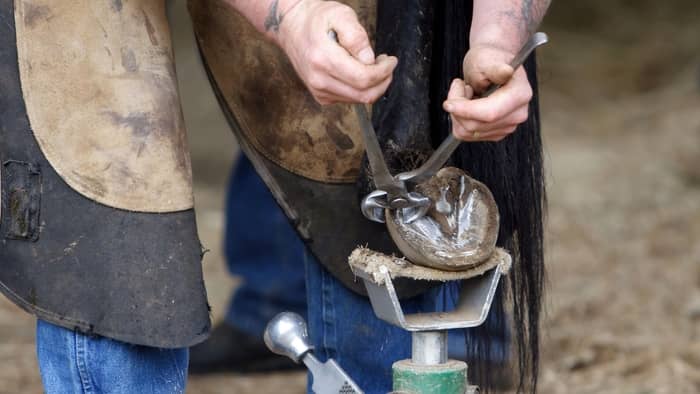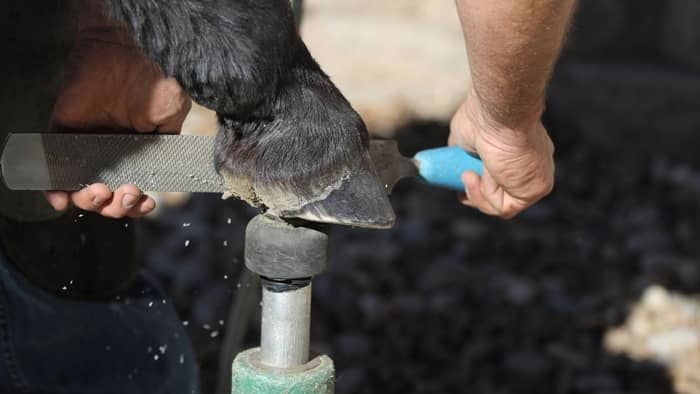Last Updated on June 11, 2022 by Guillermina
No loving owner would have one placed without asking if horseshoes hurt horses. While your beloved stallion can’t speak, there’s some clear evidence to back this answer!
Horseshoes are man made and designed to enhance and protect your horse’s hooves. They’ve been used for centuries, but as a new horse owner, you might still be hesitant to place them on your animals.
In this article, I explain what horseshoes are, how they’re put on horses, whether they hurt, and why you should consider fixing a pair on yours.
What Are Horseshoes?
Horseshoes are u-shaped metal plates fastened onto a horse’s hoof using nails. This is done to protect the foot from wear, usually on rough and uneven surfaces.
Horseshoes serve many purposes, including injury prevention, adding traction to hoofs, and correcting gait.
Before 100 BC, there seems to be no mention of horseshoes. They’re believed to be a Roman invention. Other protection methods were certainly still used before horseshoes, such as wrapping a horse’s feet in rawhide.
What Are Horseshoes Made Of
Horseshoes are manufactured using a wide variety of materials. Each horseshoe is unique to the horse’s foot and the work it does.
The most commonly used materials are metals like steel and aluminum. Specialized shoes can incorporate rubber, copper, plastic, titanium, or magnesium.
Steel horseshoes are long-wearing and preferred in sports and riding horses. A lighter shoe is preferred in horse racing, making aluminum a great choice.
How Are Horseshoes Put On
Putting up horseshoes is quite a process. Here are the steps typically involved:
- A farrier trims the insensitive part of the hoof. This is also the area into which the nails to keep the shoe secure are placed.
- Old horseshoes are removed using pincers called shoe pullers.
- The hoof wall is trimmed to the desired length with nippers, and the sole and frog of the foot are trimmed with a hoof knife.
- The farrier measures the hoof for the correct measurements of the horse’s foot, and the horseshoe is then bent to the right shape using an anvil, hammer, and forge.
- Shoes are cooled in water before attaching them to the hoof, as keeping hot shoes on the foot may cause damage.
- Special nails that bend outward when being driven in are used. These nails avoid the soft, sensitive part of the horse hoof.
- Nails are clipped and rasped flush to the hoof to prevent them from catching on anything and causing damage.
- The hoof is then filed flush with the horseshoe to eliminate sharp edges.
Do Horseshoes Hurt Horses?
Horse hooves do not have nerve endings, similar to our nails. In the same way we barely feel it when clipping nails, shoeing, and trimming a horse’s hoof does not hurt them.
Sometimes, a horse might not like being hoofed and may experience pain. If you ride an unshoed horse on rough terrain, they can develop bruises on their hooves, making shoe installation a nightmare.
If the farrier placing the horseshoes on your horse is inexperienced, they might drive the nail too deep in your horse’s hoof, causing pain. A horseshoe with a poor fit can also be uncomfortable for your horse to wear.
Some horses might dislike the hammering sound a horseshoe makes, but this doesn’t cause them any pain.
After being shoed, your horse will need a day or two to get used to their new shoes, so avoid riding them too hard during this time.
Reasons Horses Need Horseshoes
Horses need shoes for a variety of reasons. These usually are:
Protection: Wild horses travel long distances to forage for food. This causes their hooves to harden. A domesticated horse’s hooves are softer. They require shoes to protect them from hard and rough surfaces.
Injury Prevention: When the added weight of a rider, pack, or cart is placed on a horse, this causes more stress on their hooves. Horseshoes can help prevent injury to their hooves because of this extra weight.
Bone Correction: Corrective shoeing might be needed to help a horse with problems in their musculature or bones. Your farrier will be able to help you identify if your horse needs this and how to go about it.
Traction: Horseshoes with added studs, calks, or carbide tips can help a horse with traction. These are mainly used in horses doing events, shows, and jumping.
Enhance Gait: Horseshoes can manipulate a horse’s gait when walking. Some breeds are judged on their high-stepping. Special shoes can be used to enhance their natural gait.
Improved Strength: Specialized horseshoes can be used to correct a racing horse’s weakness in its leg or foot. An experienced farrier will be able to assist you with this.
To Sum It Up
Placing horseshoes on a horse doesn’t hurt them if done correctly. They can help protect your horse against injury and improve its strength. A qualified farrier will know how to fit and place horseshoes to benefit your horse.
I hope you found this article helpful and that you’re more at ease with getting horseshoes installed on your stallion. If you have any more questions about horseshoes, ask them in the comments!
FAQs
Is it cruel to put horseshoes on horses?
No.
Horseshoes are placed on the part of a horse's hoof that has no nerve endings. They don't feel any pain during or after it's been placed.
Are horseshoes good for horses?
Horseshoes can help horses in many ways and even be good for them. Placing horseshoes on your horse can help with stability, grip, and balance.
Are horses in pain when getting horseshoes?
No.
Horses don't feel any pain when horseshoes are placed on them unless the farrier isn't experienced and makes a mistake.
Why do horses need shoes when wild horses don’t?
Wild horses are used to rough terrains and don't need horseshoes to prevent injury or pain when running over these surfaces. Domesticated horses aren't used to tough terrains, and if they have to run on this for the first time, horseshoes will help ease the pain.


